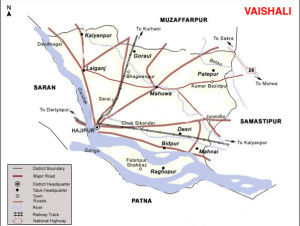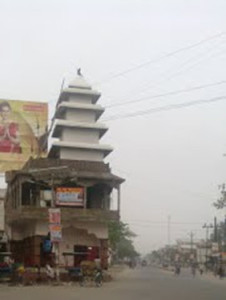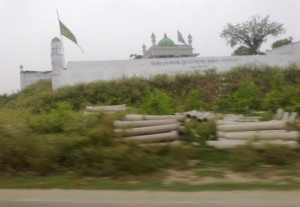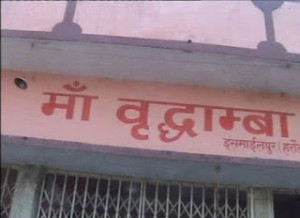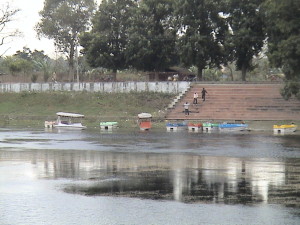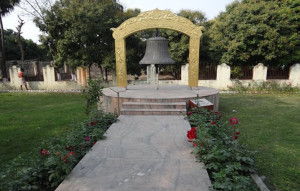Vaishali (Hajipur) District
How To Reach
By Air(Airport):-
Nearest Airport is Patna about 35 km from Hajipur.
By Rail:-
Hajipur is the headquarters of East Central Railway Zone. Three rail lines connect it to Muzaffarpur, Chhapra, and Barauni.
By Road :-
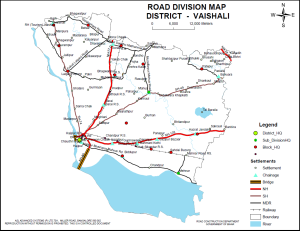 Well connected to other city through National Highway -103 State Highway- 49,74 and other road – Hajipur Bhairopur Mahnar Rd, Ganj Karharaara Road,Fakuli Lalganj Road,Muzaffarpur Mahua Road,Goraul Sandho Mathanmal Rd,Old Gandak Rd
Well connected to other city through National Highway -103 State Highway- 49,74 and other road – Hajipur Bhairopur Mahnar Rd, Ganj Karharaara Road,Fakuli Lalganj Road,Muzaffarpur Mahua Road,Goraul Sandho Mathanmal Rd,Old Gandak Rd
Hajipur is about 30 km from Patna.
Popular tourist destinations
HAJIPUR BLOCK
Gandhi Ashram(25°42’1″N 85°13’9″E) :- It is situated in the middle of the Hajipur town. Gandhiji visited this place on his way to Champaran during the movement for independence and is revered as the memorial site. In addition to a library, Gandhi’s spinning wheel and khadi life to encourage love [KVIC] is driven by the complex. Khadi garments at local shopping centers, honey, raw ghani mustard oil is available. KVI in Hajipur industrial area where the central Puny plants are designed to wear. .
Gandhi Pustakalaya :– It is located in the premise of Gandhi Ashram. It has also room to stay.
Ancient Well :- It is situated in the premise of Gandhi Ashram. Gandhiji take bathe here when stay at Ashram
Deep Narayan Singh Museum :- It is situated at Gandhi Ashram Hajipur, established in 1979 by the Directorate of Archaeology & Museum, Bihar. Before this it known as Hajipur Sangrahalaya. Among the important collections, are a stone fragment of Gupta period (4th AD– 6th Century AD), a terracotta, medieval arms, replicas of Indian coins ranging in date from Maurya (4th BC- 2nd Century AD) to the medieval period (10th AD– 17th century AD), scarce diaries of late Deep Narayan Singh, freedom fighter & Chief Minister of Bihar, and rare valuable blow-ups of local freedom fighters.
Baba Nageshwar Mandir:-
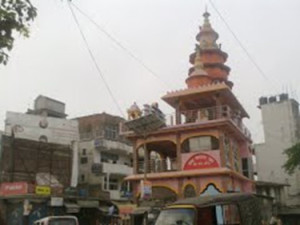 It is situated at Gandhi chauk Hajipur, established in 1960. The temple enshrine 7 inch long shivling on the base of 22 inch, with a view of Nagdev spotted on the floor. There is also a 500 kg wt statue of Lord Hanuman which is made of ….
It is situated at Gandhi chauk Hajipur, established in 1960. The temple enshrine 7 inch long shivling on the base of 22 inch, with a view of Nagdev spotted on the floor. There is also a 500 kg wt statue of Lord Hanuman which is made of ….
Siva Mandir (Anwarpur Chowk):-
Durga Mandir at Nakhash Chowk:-
Durga Mandir( Rajendra Chowk) :-
Maiya Sthan :-
Maha Kaleshwar Mandir:-The Maha Kaleshwar Mandir existing in Gali no. 1 of Naya Tola Mohalla, Hajipur. It is the temple of Shiva with statue of Hanuman jee, Goddess Durga, Chitragupta and other Hindu Gods. This temple was established with combined effort of the local people.
Bateshwar Nath Temple.:- It is situated East of Hajpur. It is dedicated of Lord. The subsistence of this holy place dates back to the Mughal era and it appeared in middle of thousand year old banyan tree and interesting tale about the temple was self constructed Temple. The temple plunges into festivity in the month of January /February during the celebration of Basant Panchami along with a sparkling month long fair prearranged on Mahashivratri.
Viswanath Shivamandir :- It is situated near Nepali Mandir, have a dalits as their chief priests It is established in 2006. During excavation around the 60-70 decade, a Bishal Shivling, about 5 ft below the ground was found. Now a day it is high up at that place, in newly constructed Mandir.
Gori Shankar Mandir :- It is located near Mahavir chauk. A new beautiful temple which houses Shivling with south oriented relief of Devi Parvati, engraved alphabet of Mantra for propitiating a deity on Argha and on the top of Shivling in Maithili inscription Ashtadal Kamal ephemeris on which Bhupur and Trisul have shown.
Pathar Masjid (Sidhi Ghat Colony) :-
Lord Krishna Temple (Acharya Prabhu Ji Ki Baithak):- It is one of the oldest temple of Hajipur. It is managed by the trusty of Gujarat.
Gumati:- The KP Jayaswal Research Institute, during in the course of its Archaeological Explorations brought to light the site period Kushana. Yusufpur:- The KP Jayaswal Research Institute, during in the course of its Archaeological Explorations brought to light the site period Shunga. Biropur:- The KP Jayaswal Research Institute, during in the course of its Archaeological Explorations brought to light the site period NBPW phase. Salempur:- The KP Jayaswal Research Institute, during in the course of its Archaeological Explorations brought to light the site period Early medieval. Sadullahpur Chandani:- The KP Jayaswal Research Institute, during in the course of its Archaeological Explorations brought to light the site period NBPW phase. Nawada Khurd:- The KP Jayaswal Research Institute, during in the course of its Archaeological Explorations brought to light the site period Medieval. Medanimal:- The KP Jayaswal Research Institute, during in the course of its Archaeological Explorations brought to light the site period NBPW phase. Titra:– The KP Jayaswal Research Institute, during in the course of its Archaeological Explorations brought to light the site period NBPW phase. Kashipur:- The KP Jayaswal Research Institute, during in the course of its Archaeological Explorations brought to light the site period NBPW phase. Phulhara Bano:- The KP Jayaswal Research Institute, during in the course of its Archaeological Explorations brought to light the site period NBPW phase. Saidpur Jagadish:- The KP Jayaswal Research Institute, during in the course of its Archaeological Explorations brought to light the site period NBPW phase. Helalpur Madarpur:- The KP Jayaswal Research Institute, during in the course of its Archaeological Explorations brought to light the site period NBPW phase.
Quila Laroi:- The KP Jayaswal Research Institute, during in the course of its Archaeological Explorations brought to light the site period Medieval. Bejha:- The KP Jayaswal Research Institute, during in the course of its Archaeological Explorations brought to light the site period NBPW phase.
Manuwa Dih:- According to Jayaswal Research Institute Archaeological Explorations this site belongs to NBPW phase period.
Astipur Masjid (Manua ):-
Astipur Eidgaah:-
Chakwara (Chak Shekh):- The KP Jayaswal Research Institute, during in the course of its Archaeological Explorations brought to light the site period Chalcolithic. Pokhara Mohala:- The KP Jayaswal Research Institute, during in the course of its Archaeological Explorations brought to light the site period Medieval. Katara Bharat Raut:- The KP Jayaswal Research Institute, during in the course of its Archaeological Explorations brought to light the site period Early medieval. Daulatpur Deoaria:- The KP Jayaswal Research Institute, during in the course of its Archaeological Explorations brought to light the site period Medieval. Saman Chak:- The KP Jayaswal Research Institute, during in the course of its Archaeological Explorations brought to light the site period Gupta. Hela Bazar:- The KP Jayaswal Research Institute, during in the course of its Archaeological Explorations brought to light the site period Medieval.
Konhara Ghat:- According to Jayaswal Research Institute Archaeological Explorations this site belongs to Gupta period.
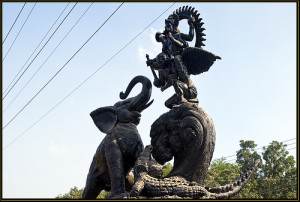 It is situated at the confluence of the Gandak and Ganges in Hajipur.It is traditionally believed to be the place where the mythical elephant was
It is situated at the confluence of the Gandak and Ganges in Hajipur.It is traditionally believed to be the place where the mythical elephant was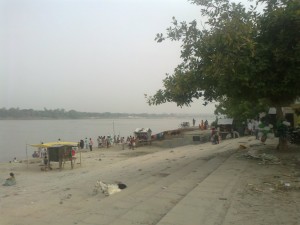 caught by a crocodile and Lord Vishuna got it released. According to this legend, “The famous fight of Gaja(elephant)-Graah (crocodile), which is well covered in Indian scriptures, is the reason behind people asking -kaun haara. Hence the name. Scriptures tell that Lord Vishnu had to interfere in the fight to save his devotee Gajaraj, who was being drowned by crocodile. Both Gaja and Grah were gandharvas. But due to some curse they became Gaja and Graah. Lord Vishnu killed Graah to give him instant salvation, and saved life of Gajaraj.
caught by a crocodile and Lord Vishuna got it released. According to this legend, “The famous fight of Gaja(elephant)-Graah (crocodile), which is well covered in Indian scriptures, is the reason behind people asking -kaun haara. Hence the name. Scriptures tell that Lord Vishnu had to interfere in the fight to save his devotee Gajaraj, who was being drowned by crocodile. Both Gaja and Grah were gandharvas. But due to some curse they became Gaja and Graah. Lord Vishnu killed Graah to give him instant salvation, and saved life of Gajaraj.
Although it is the preferred spot for cremations, the view from here is stunning, especially at sunset.
Kabir Math(Konhara Gath) :-
Badi Durga(Konhara Gath):-
Kali Mandir:-
Shiv & Surya Temple (Khonharagath) :-
Church (Khonhargath):-
Ander kila (Sehjadpur):- The KP Jayaswal Research Institute, during in the course of its Archaeological Explorations brought to light the site period Early medieval.
Nepali Temple (Anderkilla):- According to Jayaswal Research Institute Archaeological Explorations this site belongs to Late medieval period.
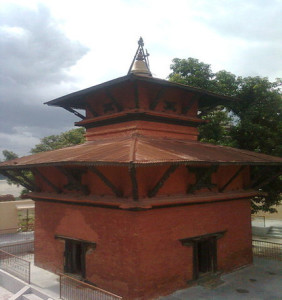 It is about 6 km west of Hajipur, on the confluence of the Gangas, the Gandak
It is about 6 km west of Hajipur, on the confluence of the Gangas, the Gandak 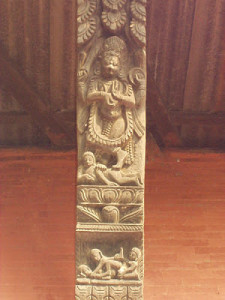 and the Mahi at Kunahra ghat. It is unique two story Shaivite shrine. Made in the late medieval period (18th century), by Mathabar Singh Thapa, one of the army commanders of Nepal. The temple brings-in a fresh pagoda-style architecture of the Himalayan Kingdom to the plains of the Ganga. This temple is built largely of wood. It is known for the Khajuraho -like erotic carvings on its wooden pillars that depict the journey of mankind for sexuality to spirituality .
and the Mahi at Kunahra ghat. It is unique two story Shaivite shrine. Made in the late medieval period (18th century), by Mathabar Singh Thapa, one of the army commanders of Nepal. The temple brings-in a fresh pagoda-style architecture of the Himalayan Kingdom to the plains of the Ganga. This temple is built largely of wood. It is known for the Khajuraho -like erotic carvings on its wooden pillars that depict the journey of mankind for sexuality to spirituality .
Along with Shivalinga some medieval sculptures are found housed in this temple.
Lodipur:- The KP Jayaswal Research Institute, during in the course of its Archaeological Explorations brought to light the site period Early medieval. Minapur:- The KP Jayaswal Research Institute, during in the course of its Archaeological Explorations brought to light the site period NBPW phase. Rambhadra:- The KP Jayaswal Research Institute, during in the course of its Archaeological Explorations brought to light the site period NBPW phase. Nawada Kala:- The KP Jayaswal Research Institute, during in the course of its Archaeological Explorations brought to light the site period Early medieval. Hathisar Ganj:- The KP Jayaswal Research Institute, during in the course of its Archaeological Explorations brought to light the site period Early medieval.
Tomb of Bar Khurdar Aulia Shaheb( Hatsarganj ):- The tomb of Barkhurdar Aulia Shaheb is situated near Hatsarganj police outpost.
Bahuwara:-The KP Jayaswal Research Institute, during in the course of its Archaeological Explorations brought to light the site period Early medieval. Bishunpur Chaktola (Baranti):- The KP Jayaswal Research Institute, during in the course of its Archaeological Explorations brought to light the site period Early medieval. Chandaleh Mound:- The KP Jayaswal Research Institute, during in the course of its Archaeological Explorations brought to light the site period Early medieval. Shubhai Garh:- The KP Jayaswal Research Institute, during in the course of its Archaeological Explorations brought to light the site period NBPW phase. Senduari:- The KP Jayaswal Research Institute, during in the course of its Archaeological Explorations brought to light the site period NBPW phase. Thathan Bujurg:- The KP Jayaswal Research Institute, during in the course of its Archaeological Explorations brought to light the site period Early medieval. Loma Dih:- The KP Jayaswal Research Institute, during in the course of its Archaeological Explorations brought to light the site period NBPW phase. Bakarpur:- The KP Jayaswal Research Institute, during in the course of its Archaeological Explorations brought to light the site period Shunga-Kushan. Akilabad (Chakniamat):- The KP Jayaswal Research Institute, during in the course of its Archaeological Explorations brought to light the site period Early medieval. Minapur Rai:- The KP Jayaswal Research Institute, during in the course of its Archaeological Explorations brought to light the site period NBPW phase. Dighi Khurd:- The KP Jayaswal Research Institute, during in the course of its Archaeological Explorations brought to light the site period Late medieval
Arara Garh:- The KP Jayaswal Research Institute, during in the course of its Archaeological Explorations brought to light the site period Early medieval. Magarhatta:- The KP Jayaswal Research Institute, during in the course of its Archaeological Explorations brought to light the site periodEarly medieval. Ajmatpur:- The KP Jayaswal Research Institute, during in the course of its Archaeological Explorations brought to light the site period Medieval. Dighi Kala Dih:- The KP Jayaswal Research Institute, during in the course of its Archaeological Explorations brought to light the site period NBPW phase. Ghoshwar Dih:- The KP Jayaswal Research Institute, during in the course of its Archaeological Explorations brought to light the site period Chalcolithic. Sapha:- The KP Jayaswal Research Institute, during in the course of its Archaeological Explorations brought to light the site period Shunga-Kushana. Pahetiya:- The KP Jayaswal Research Institute, during in the course of its Archaeological Explorations brought to light the site period NBPW phase. Randaha:- The KP Jayaswal Research Institute, during in the course of its Archaeological Explorations brought to light the site period NBPW phase. Chaksaid:- The KP Jayaswal Research Institute, during in the course of its Archaeological Explorations brought to light the site period NBPW phase. Andharwara:- The KP Jayaswal Research Institute, during in the course of its Archaeological Explorations brought to light the site period Medieval. Kashipur Dih:- The KP Jayaswal Research Institute, during in the course of its Archaeological Explorations brought to light the site period Neolithic. Purva:- The KP Jayaswal Research Institute, during in the course of its Archaeological Explorations brought to light the site period Late medieval. Gaushpur (Izra):- The KP Jayaswal Research Institute, during in the course of its Archaeological Explorations brought to light the site period Early medieval. Kunwarki Khurd (Balwa Kuwari):– The KP Jayaswal Research Institute, during in the course of its Archaeological Explorations brought to light the site period Early medieval. Qutubpur:- The KP Jayaswal Research Institute, during in the course of its Archaeological Explorations brought to light the site period Kushana. Ismailpur-Dumari:– The KP Jayaswal Research Institute, during in the course of its Archaeological Explorations brought to light the site period Medieval. Bajitpur Dih:- The KP Jayaswal Research Institute, during in the course of its Archaeological Explorations brought to light the site period Shunga.Bhatandhi:- The KP Jayaswal Research Institute, during in the course of its Archaeological Explorations brought to light the site period Medieval. Chhoti Marahi:- The KP Jayaswal Research Institute, during in the course of its Archaeological Explorations brought to light the site period Shunga. Dayalpur Garh:-The KP Jayaswal Research Institute, during in the course of its Archaeological Explorations brought to light the site period Medieval. Chapta:- The KP Jayaswal Research Institute, during in the course of its Archaeological Explorations brought to light the site period Early medieval.
Tomb of Makhdum Shah Abul Fateh Hidayatullah Sarmast (RA) (Tangaul):-
Hazrat Abul Fatah Hidayatullah Sarmast (RA) was third son of Hazrat Alauddin Kazan Shattari and Khilafat was further Passed on to 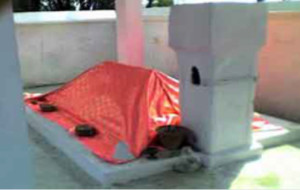 Hazrat Abul Fatah Hidayatullah Sarmast (d.1538) (12th Shawwal 944 hijri). The Dargah Shareef of Hazrat Abul Fatah Hidayatullah Sarmast (RA) is located in a small village Tangaul, around 20 kilometres from Patna. This Village is situated on the banks of Ganga River. Famous Mughal king Humayun was a dedicated follower of Hazrat Abul Fatah Hidayatullah Sarmast and took his advice on worldly, political and spiritual issues.
Hazrat Abul Fatah Hidayatullah Sarmast (d.1538) (12th Shawwal 944 hijri). The Dargah Shareef of Hazrat Abul Fatah Hidayatullah Sarmast (RA) is located in a small village Tangaul, around 20 kilometres from Patna. This Village is situated on the banks of Ganga River. Famous Mughal king Humayun was a dedicated follower of Hazrat Abul Fatah Hidayatullah Sarmast and took his advice on worldly, political and spiritual issues.
According to Jayaswal Research Institute Archaeological Explorations this site belongs to Medieval period.
Jarhua:- The KP Jayaswal Research Institute, during in the course of its Archaeological Explorations brought to light the site period NBPW phase.
Mamu Bhanja Mazar (Jadhua)
The KP Jayaswal Research Institute, during in the course of its Archaeological Explorations brought to light the site period Medieval
Shaista Khan, the maternal uncle of Aurangzeb, erected a tomb known as Mamu Bhagana ki Kabar. It is situated near the pond of Shivai Singh in the mouza of Jarwa on Hajipur Jarwa Road.
According to Jayaswal Research Institute Archaeological Explorations this site belongs to medieval period.
Sanchipatti:- The KP Jayaswal Research Institute, during in the course of its Archaeological Explorations brought to light the site period Medieval.
Ramchura Mandir :-
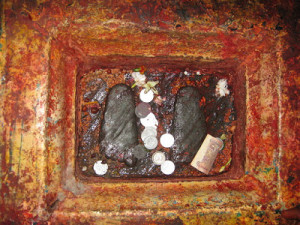 It is located at Rambhadra near Hela Bazar, Hajipur , where a fair is held every year on Ram Navami day. The local tradition has it that lord Ramchandra had a stopover here for a bath on his way to Janakpur. There are some marks on stone, which are said to be his foot-prints.
It is located at Rambhadra near Hela Bazar, Hajipur , where a fair is held every year on Ram Navami day. The local tradition has it that lord Ramchandra had a stopover here for a bath on his way to Janakpur. There are some marks on stone, which are said to be his foot-prints.
The temple is situated on the top of a soil mound.
Excavation revealed an ancient site yielding NBP Ware and associated wares and pottery of the Sunga, Kushana, Gupta and Medieval times. Archeological objects excavated from Ramchaura are kept at the Patna Museum.
Also according to Jayaswal Research Institute Archaeological Explorations this site belongs to NBPW phase period.
Fort & Jami Masjid :-
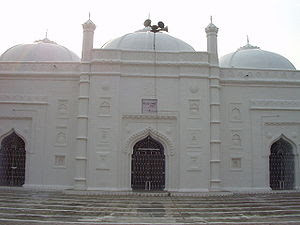 It is situated about 3 km north of Hajipur railway station near DM residence can be reached by SDO road. The town is known by the name of Hajipur as it was founded by a King of Bengal named Haji Ilyas Shah who ruled between 1345 to 1358 A.D. Inside the fort built by this king in Hajipur there is a mosque called Jami Masjid, a plain building measuring 84.5 ft. long and 33.5 ft. broad. The mosque is crowned by three domes, the central one being larger than the others. An inscription over its stone gateway records its erection in the year 1587 A.D. during the reign of the Mughal Emperor, Akbar by Makhsus Shah who according to the Akbarnamah was the brother of Said Khan, the governor of Bihar Sharif. The Jami Masjid of Hajipur is one of the most remarkable monuments belonging to the Mughal period.
It is situated about 3 km north of Hajipur railway station near DM residence can be reached by SDO road. The town is known by the name of Hajipur as it was founded by a King of Bengal named Haji Ilyas Shah who ruled between 1345 to 1358 A.D. Inside the fort built by this king in Hajipur there is a mosque called Jami Masjid, a plain building measuring 84.5 ft. long and 33.5 ft. broad. The mosque is crowned by three domes, the central one being larger than the others. An inscription over its stone gateway records its erection in the year 1587 A.D. during the reign of the Mughal Emperor, Akbar by Makhsus Shah who according to the Akbarnamah was the brother of Said Khan, the governor of Bihar Sharif. The Jami Masjid of Hajipur is one of the most remarkable monuments belonging to the Mughal period.
Also here lie a portion of Ananda,s Ashes.
Baba Pataleshwar Mandir:-
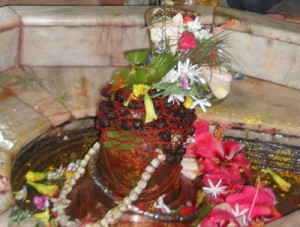 It is located at Tajpur Muhalla of Hajipur on Jarwa to Narvash road.This temple came in existence from 1888-1895. It is belived that the Shivalinga, came out automatically from the deep surface of the earth (Patallok). Renovation of Mandir is done in the year 1934-35.This Temple has a number of statues of Hindu deities.
It is located at Tajpur Muhalla of Hajipur on Jarwa to Narvash road.This temple came in existence from 1888-1895. It is belived that the Shivalinga, came out automatically from the deep surface of the earth (Patallok). Renovation of Mandir is done in the year 1934-35.This Temple has a number of statues of Hindu deities.
It is believed that at one point of time Lord Shiva had appeared and decided upon to reside there forever in the form of lingam. The temple is also adorned with anthropomorphic images оf Lord Shiva which are worshipped along with the lingam by the devotees who seek Lord’s blessings and grace. During Shivratri, the temple is ornamented attractively and devotees make offerings and pray for destruction of evils from their lives. There is a wedding pavilion temple complex where matrimonial rituals are performed whole year and has been widely as well as officially recognized.
Shah Idrish Mazar :-
Suklain Mandir :-
Hajipur Karbala :- It was constructed by Shah Alam. It attracts a large crowd of Muslims throughout the years.
Tomb of Hafiz BarkhurdarIn(Khatte Ruknuddin) :-
Tomb of Ruknuddin Shahe(Khatte Ruknuddin) :- He is disciple of Hafiz BarkhurdarIn.
Jagdamba Temple(Gadai Sarai):-
Bishhar Mandir (Gadai Sarai) :-
Baba Bari Vishal Temple (Maksudpur Road):-
Budhia Mai Temple:-
Budhi Mai Temple is situated in Vaishali Haruli, Ismailpur, near the State Bank of India, Lalganj Road. Budhi Mai Mela is held in the month of July and August on Budhi Mai Campus, attracting visitors from all over Bihar.
Bhuinya Asthan:- It is situated 10 kilometers northeast to Hajipur. It is a market place near Langa – Shubi Vriksh. Business person and farmers Bhuinya place great faith. People gather here for worship here on every Monday and Friday to offer milk to the idol.
Tomb of Haji Ilyas:- The town name; Hajipur is known, as it was founded by a King of Bengal named Haji Ilyas Shah who ruled between 1345 to 1358 A.D. His Tomb with tomb of Haji Herman are located next to the Mosque near DM House.
VAISHALI BLOCK
Vaishali Mahotsava.:- Vaishali Mahotsava is held every year on Baisakh Purnima (Full Moon Day of 1st Hindu Month) during mid-April to celebrate the birth anniversary of 24th Jain Tirthankar Lord Mahavir who born here in the village Kundalpur, 4 km from Vaishali. The soil of this land is blessed by the visit of Lord Buddha twice during 3rd century BC.
Raja Vishal ka Garh :- It is located about 35 km from Hajpur at Basarh village. A huge mound with a circumference about one 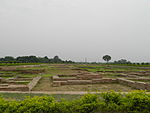 Kilometer and walls nearly 2 m high with a 43 m wide moat around them, is said to be the ancient parliament house of Vajji’s Republic(600 B.C), the world’s first Republic. Over seven thousand representatives of the federal assembly gathered here to legislate and discuss the problems of the day. Now it look like ruins of a fort. As a result of excavation the remains of a community well was found. Many antiquities remains like terracotta objects such as ball,beads,disc,ear studs,etc and toy cart, iron rings, and objects made of copper, bone and ivory were found from this site.
Kilometer and walls nearly 2 m high with a 43 m wide moat around them, is said to be the ancient parliament house of Vajji’s Republic(600 B.C), the world’s first Republic. Over seven thousand representatives of the federal assembly gathered here to legislate and discuss the problems of the day. Now it look like ruins of a fort. As a result of excavation the remains of a community well was found. Many antiquities remains like terracotta objects such as ball,beads,disc,ear studs,etc and toy cart, iron rings, and objects made of copper, bone and ivory were found from this site.
Bat sanctuary :- Huge number of Bats are home near Raja Vishal Garh, on the Banyan tress. It can be develop as a bat sanctuary.
Bawan Pokhar Temple :- Bawan Pokhar is locally know as Bauna Pokhar. Temple lies on the northern bank of the Bawan Pokhar. It is believed to have been built during the Pallava Period. The temple consists an interesting array of basalt black images of several deities, which dated back to the Gupta and Pallavr periods
Lotus Tank :- A little distance from bawan pokhar temple lies the Lotus Tank which used to be a picnic spot of the Lichchhavis.
Relic Stupa (Lichhavi Stupa):-
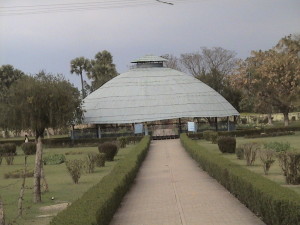 It is situated near Abhishek Pushkarini tank about 35 km from district headquarter Hajipur of Vaishali district. In 1957-1962 in an archaeological excavation this Stupa came into light. Lichhavi built this stupa in any time between 600 and 200 BC, over their share of
It is situated near Abhishek Pushkarini tank about 35 km from district headquarter Hajipur of Vaishali district. In 1957-1962 in an archaeological excavation this Stupa came into light. Lichhavi built this stupa in any time between 600 and 200 BC, over their share of 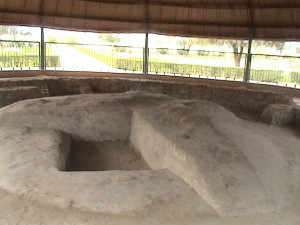 the 8th part of holy mortal remains (Relic) of Lord Buddha. The partially full Relic Casket was discovered in this excavation. The casket contained, besides the ashes of Lord Buddha mixed with earth, a piece of Conch, two glass Beads, a small piece of Gold- Leaf and a copper punch-marked Coin. Since 1972, the holy “Relic of Lord Buddha’ has been preserved in Patna Museum. This excavation also revealed that the Stupa at Vaishali, was enlarged & repaired 4 times respectively during Mauryan, Sunga & Kushan dynasty, which is also seen today. The relic -casket was only partially full seems to confirm, as tradition says, the stupa had been opened up its relics by Asoka, who is also said to have left behind a portion of relics for worship by the Lichchhavis.
the 8th part of holy mortal remains (Relic) of Lord Buddha. The partially full Relic Casket was discovered in this excavation. The casket contained, besides the ashes of Lord Buddha mixed with earth, a piece of Conch, two glass Beads, a small piece of Gold- Leaf and a copper punch-marked Coin. Since 1972, the holy “Relic of Lord Buddha’ has been preserved in Patna Museum. This excavation also revealed that the Stupa at Vaishali, was enlarged & repaired 4 times respectively during Mauryan, Sunga & Kushan dynasty, which is also seen today. The relic -casket was only partially full seems to confirm, as tradition says, the stupa had been opened up its relics by Asoka, who is also said to have left behind a portion of relics for worship by the Lichchhavis.
Abhiskek Pushkarni (Coronation tank, Kharuna Pokhra):-
It is situated about 1 km to the north- west of the Raja Vishal ka Garh. Surrounded by flowering trees the tank, now called kharauna Pokhara is locally believed to represent the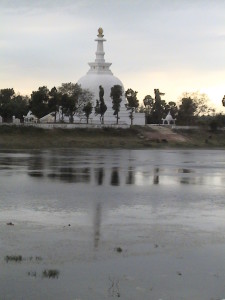 ancient Abhishek Pushkarini of the Lichchhavis. It contains water that was believed to be sacred in the old days. It is believed that before coronation of Lichhavi’s (6 century BC – 5 century AD) kings had to be first ‘anointed before being crowned’, with the sacred water of this holy tank.
ancient Abhishek Pushkarini of the Lichchhavis. It contains water that was believed to be sacred in the old days. It is believed that before coronation of Lichhavi’s (6 century BC – 5 century AD) kings had to be first ‘anointed before being crowned’, with the sacred water of this holy tank.
Ghanta :-
It is situated near Abhishek Pushkarni.
Visva Shanti Stupa :- World Peace Pagoda also called Vishwa Shanti Stupa was built by Japanese Nichiren Buddhist sect Nipponzan Myohoji on the south bank of the coronation tank, a sixth in the series to be
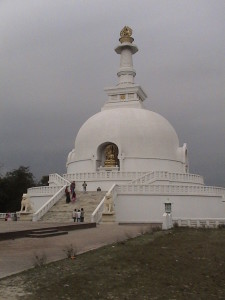 e
e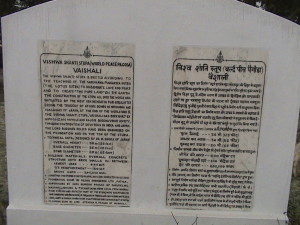 rected in India. The Stupa enshrined a small part of Buddha’s relics. The purposes to built the Stupa was to create peace in the world.
rected in India. The Stupa enshrined a small part of Buddha’s relics. The purposes to built the Stupa was to create peace in the world.
Archaeological Museum, Vaishali :-It is situated on the bank of the Abhiseka Pushkarini. Freedom Fi ghter late Sri Bijuli Pr Singh is the founder of this Museum. The museum was set up in 1971 to preserve the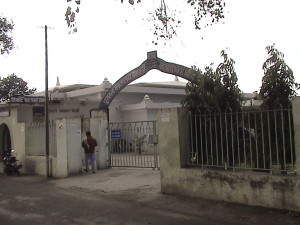 antiquities found during exploration and excavation in and around the area. It has four galleries. The Museum first gallery displays the terracotta objects like human figurines, Naigamesha, mother and child, Durga, plaque of Buddha, another plaque showing image of
antiquities found during exploration and excavation in and around the area. It has four galleries. The Museum first gallery displays the terracotta objects like human figurines, Naigamesha, mother and child, Durga, plaque of Buddha, another plaque showing image of 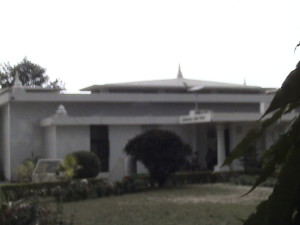 Bodhisattva and a female figure. In addition to this stone Chitravali, moulded bricks and brick tiles are also on display. The important exhibits in the second gallery are terracotta figurines of ram, elephant, horse, bull, dog, monkey, birds, snake hood, seals and sealing, wheel, rattle, dabber, beads, toilet pan of terracotta, copper punch marked and cast coins, etc.The third gallery displayed Potsherds of NBP and PGW, objects like antler, bone, bangle, arrowheads, iron and copper implements like knife, nail, bell, etc. The fourth gallery contains exhibits like earthen ware such as bowl, dish, miniature vessel, vase, lamp, inkpot, lid bell, sprinkler and spout etc.
Bodhisattva and a female figure. In addition to this stone Chitravali, moulded bricks and brick tiles are also on display. The important exhibits in the second gallery are terracotta figurines of ram, elephant, horse, bull, dog, monkey, birds, snake hood, seals and sealing, wheel, rattle, dabber, beads, toilet pan of terracotta, copper punch marked and cast coins, etc.The third gallery displayed Potsherds of NBP and PGW, objects like antler, bone, bangle, arrowheads, iron and copper implements like knife, nail, bell, etc. The fourth gallery contains exhibits like earthen ware such as bowl, dish, miniature vessel, vase, lamp, inkpot, lid bell, sprinkler and spout etc.
Opening Hours : 10.00 am to 5.00 pm
Closed on – Friday
Jain Temple :- It is near the Bawan Pokhar. A new beautiful Jain Temple which houses statues of 22 inch high black stone ancient Tirthankaras Mahavira, was built near by just to the west of the old temple. Previously this statues was in the old temple, now enshrined in this newly built temple .
Charan chinha:- It is about 93 sq. inch charan chinha of Thrithkar Mahvir, engrave in marble is situated near the temple.
Vietnam Temple at Vaishali:-
Lord Buddha Statue at Vaishali:-
Chaturmukhi Mahadeva (Kampan chapra) :- It is located about 1 km east-north from gadh at Kampan chapra village. During excavation in year 1945 a four headed Shivling made of black basalt was found . In year 1974 further excavation revealed the remains of a temple. Now a day new temple was built on the ruins of old temple. Engraved inscription has been seen in base of the statue.
Amrapali Stupa / Pir Ka Mazar :- It is located about 300 meters from Raja Vishal Ka Garh, at Gargaah village of Vaishali Panchayat. A Mound of 24 feet high & diameter of 140 feet. Now this place is known as ‘Pir Ka Mazar’. 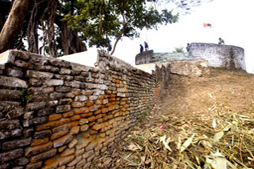 In Buddhist period, this place was the Mango-Garden (Amravana) of the great dancer Amrapali of Magadha dynasty. According to Maha Parinibbana Sutta, Lord Buddha stayed in this Amarvana, in his last visit of Vaishali. On this holy place Buddha announced his Mahaparinirvana after staying here for a few days, he went to Pava (Siwan). On his last visit to Vaishali, Knowing the news, Amrapali, came in this Amravana and invited Lord Buddha & his disciples for dinner. She gifted this Amravana to the ‘Bhikshuk Sangh’ in the regard of Buddha & also became his ‘first female disciple’. After this Mahaparinirvana (543 BC) in the memory of Lord Buddha, Stupa was built at the place of Amravana which was later, known as ‘Ambapali stupa’. Now this place is known as ‘Pir ka Mazar’. Mausoleum of Hazrat Makhdum Shah Kazin (Sheikh Kazin Suttari), who came here, in 15th century AD, and spread sufism.
In Buddhist period, this place was the Mango-Garden (Amravana) of the great dancer Amrapali of Magadha dynasty. According to Maha Parinibbana Sutta, Lord Buddha stayed in this Amarvana, in his last visit of Vaishali. On this holy place Buddha announced his Mahaparinirvana after staying here for a few days, he went to Pava (Siwan). On his last visit to Vaishali, Knowing the news, Amrapali, came in this Amravana and invited Lord Buddha & his disciples for dinner. She gifted this Amravana to the ‘Bhikshuk Sangh’ in the regard of Buddha & also became his ‘first female disciple’. After this Mahaparinirvana (543 BC) in the memory of Lord Buddha, Stupa was built at the place of Amravana which was later, known as ‘Ambapali stupa’. Now this place is known as ‘Pir ka Mazar’. Mausoleum of Hazrat Makhdum Shah Kazin (Sheikh Kazin Suttari), who came here, in 15th century AD, and spread sufism.
Vainkteshwar Mandir :- It is an ancient Temple. Stivension in 1834 during his Vaishali tour had seen this temple under construction. This is a modern temple which was made by the co-operations of the villagers. Before this, eight metal statues were found which later got stolen away.
Mazar-e-Mubarak Hazrat Alauddin Kazan Shattari (RA) :-
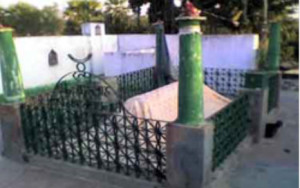 Khilafat from Hazrat Abdullah Shattari (RA) was passed on to Hazrat Alauddin Kazan Shattari (RA) also known as Hazrat Shaikh Mohammed Ulaa (RA) (d.1495) (11th shawwal 901 hijri). After receiving Khilafat he worked on his own spirituality, attained enlightenment and spent rest of his life in propagating spiritual Sufi messages in Shattari way. He lived in Muzaffarpur.
Khilafat from Hazrat Abdullah Shattari (RA) was passed on to Hazrat Alauddin Kazan Shattari (RA) also known as Hazrat Shaikh Mohammed Ulaa (RA) (d.1495) (11th shawwal 901 hijri). After receiving Khilafat he worked on his own spirituality, attained enlightenment and spent rest of his life in propagating spiritual Sufi messages in Shattari way. He lived in Muzaffarpur.
Shrine of Hazrat Alauddin Kazan Shattari is located on a small hill in a small town near vaishali garh. Near to his shrine we can find shrine of his eldest son Makhdoom Mansoor Hallaj Shaheed.
Badshah Ke Pir :- His original name was Taqiuddin urf Budhe. He was the grandson of Syed Mohammad kalpavi and the pir(spiritual master) of the king of that kingdom, Daud Shah. The capital of that kingdom was Hajipur, presently a small town near Patna, Bihar, India. He invited him to his capital where his shrine exists today and is famous as the shrine of Badshah ke pir(master of the king).
Chakramdas (Stupa):- It is located about 3 km north-west of the fort at Chakramdas village. In Buddhist period, on this place there was a ‘holy tank’ near to a ‘Shelter-House’ (Chapaal Chaitya)where Lord Buddha walked & took shelter on his Vaishali trip. Lord Buddha liked this place because this place was also related to Buddha’s past life. 
According to Hiuen-Tsiang, Lord Buddha told his past life story to his disciples that – in the past life he, with his thousand brothers, surrendered their arms in front of his mother. In the past life he was ‘Saharsha Buddha’. In the excavation a horde of more than a hundred punch marked coins and many rare antiquities, styli of bone, terracotta etc. were found.
According to Jayaswal Research Institute Archaeological Explorations this site belongs to NBPW phase period.
Baniya:- It is located in North of the Chkramadas. According to a Jain tradition Lord Mahavira, 24th and the last of the Tirthankaras (599-527 BC) was born at Kundagrama and at Vaniyagrama was his residence, both the places being part of or near Vaishali. While the modern village of Baniya can be taken as representing the site of ancient Vaniagrama. Excavation at this place revealed an shrine of brick having a projected opening on the south. The associated antiquities found was terracotta figurines, it show that the shrine belonged to the Gupta age. Immediately to Its north-east were the ruins of a small platform like brick structure, and it is guessed that both the structures formed parts of a much bigger complex.
Chaturmukhi Mahadeva (Baniya) :- It is located about 1 km east-north from Abhishek Pushkarni at Baniya village. It is believed to have built during the Pala period.
Ramjanki Mandir (Harikatora Temple) :- It is situated in the village Basadh.Temple was constructed during the year 1934-1935 by Saint Khaki baba with the cooperation of the local people. The highlight here is an image of Lord Kartikeya, which is in a sitting posture on a peacock, to have been built during the Gupta period. Traditionally believed that during the course of on way of Janakpur Bhagwan Ram stopover here for a night and a katora of Sri Ram was left behind this place, so the place is known as Harikatora. This temple is in a ruined state now.
Ancient Well :- It is located near Ramjanki temple
Hazrat Abul Faiz Qazin Ola (Bania Basarh):- It is located at Bania Basarh. It is shrine of the one of the greatest Sufis of the Shuttaria order, Hazrat Abul Faiz Qazin Ola.
Lalpur:- It is situated South of the Chkramadas. Excavation yielded the N.B.P.Were and associated terracotta figurines indicating that the sit had been deserted long before the Christian era..
Sauyad haji ka Mazar Vaishali:- It is oldest maqbara built by king Jahangir( 1605-1627A.D).
Miranji ka Dargah(Vaishali) :- The dargah houses the relics of Sheikh Mohammed Faizullah Kazim, a saint of the 15th century. On the occasion of Id-ul-Fitar, Muslims from the neighbouring areas come here to pay their respects to the saint
Hasanpur:- The KP Jayaswal Research Institute, during in the course of its Archaeological Explorations brought to light the site period NBPW phase. Belka:- The KP Jayaswal Research Institute, during in the course of its Archaeological Explorations brought to light the site period Early medieval. Ghogha (Dharhara):- The KP Jayaswal Research Institute, during in the course of its Archaeological Explorations brought to light the site period NBPW phase. Muhammadpur:- The KP Jayaswal Research Institute, during in the course of its Archaeological Explorations brought to light the site period Medieval. Husaina Ragho:- The KP Jayaswal Research Institute, during in the course of its Archaeological Explorations brought to light the site period Medieval. Majhauli:- The KP Jayaswal Research Institute, during in the course of its Archaeological Explorations brought to light the site period Medieval. Salempur:- The KP Jayaswal Research Institute, during in the course of its Archaeological Explorations brought to light the site period NBPW phase.
Kamman Chapra:- The KP Jayaswal Research Institute, during in the course of its Archaeological Explorations brought to light the site period Gupta. Hamidpur (Shahjahanpur):- The KP Jayaswal Research Institute, during in the course of its Archaeological Explorations brought to light the site period Early medieval. Qutubpur Bangri:– The KP Jayaswal Research Institute, during in the course of its Archaeological Explorations brought to light the site period NBPW phase. Jhitkahiya:- The KP Jayaswal Research Institute, during in the course of its Archaeological Explorations brought to light the site period NBPW phase. Kamtauliya:- The KP Jayaswal Research Institute, during in the course of its Archaeological Explorations brought to light the site period Medieval. Daudnagar:- The KP Jayaswal Research Institute, during in the course of its Archaeological Explorations brought to light the site period Medieval.
Shah Mosaheb Ali Quadri R.A:-
Chak Mansur:- The KP Jayaswal Research Institute, during in the course of its Archaeological Explorations brought to light the site period Early medieval. Chak Daulat:- The KP Jayaswal Research Institute, during in the course of its Archaeological Explorations brought to light the site period Late medieval. Shampur:- The KP Jayaswal Research Institute, during in the course of its Archaeological Explorations brought to light the site period Late medieval.
Bhagwanpur:- Bhagwanpur Village is settled on a big mound spread over a large area. In the western corner of the village is a tank (pond) and by its side is big stupa shaped mound . On top of the mound is a temple. The temple is very popular among the locals.
According to Jayaswal Research Institute Archaeological Explorations this site belongs to Early medievalperiod.
Barela Salim Ali Zubba Saheni Wildlife Sanctuary:- It is a naturally occurring sanctuary, such as an island, that provides protection for species from hunting, predation or competition. It is declared a protected area in 1997, a geographic territory within which wildlife is protected which has an area of 0.8 sq. mi and 1.96 ac.
Balukaram:- This an ancient village situated on the Hajipur Vaishali road 30 km north of Hajipur.The sixth world Buddhist Conference was held here.
SAHDAI BUZURG BLOCK
Murauwatpur:- The KP Jayaswal Research Institute, during in the course of its Archaeological Explorations brought to light the site period Late medieval. Nayagaon Urf Muradpur:- The KP Jayaswal Research Institute, during in the course of its Archaeological Explorations brought to light the site period Early medieval. Fatehpur Bujurg:- The KP Jayaswal Research Institute, during in the course of its Archaeological Explorations brought to light the site period NBPW phase. Rampur Dih:- The KP Jayaswal Research Institute, during in the course of its Archaeological Explorations brought to light the site period Early medieval. Shekhopur Dih:- The KP Jayaswal Research Institute, during in the course of its Archaeological Explorations brought to light the site period NBPW phase. Bhagawati;– The KP Jayaswal Research Institute, during in the course of its Archaeological Explorations brought to light the site period NBPW phase. Pohiar:- The KP Jayaswal Research Institute, during in the course of its Archaeological Explorations brought to light the site period Late medieval. Mausai Dih:- The KP Jayaswal Research Institute, during in the course of its Archaeological Explorations brought to light the site period NBPW phase.
CHEHRA KALAN BLOCK
Bangari (Bakhari Sultan & Chainpur):- The KP Jayaswal Research Institute, during in the course of its Archaeological Explorations brought to light the site period NBPW phase. Akhtiyarpur Sehan:– The KP Jayaswal Research Institute, during in the course of its Archaeological Explorations brought to light the site period NBPW phase. Mansurpur Halaiya dih:- The KP Jayaswal Research Institute, during in the course of its Archaeological Explorations brought to light the site period Chalcolithic. Mustafapur:- The KP Jayaswal Research Institute, during in the course of its Archaeological Explorations brought to light the site period Late medieval. Bathna Mahodat:- The KP Jayaswal Research Institute, during in the course of its Archaeological Explorations brought to light the site period Late medieval. Chota Halaiya Dih (Mansurpur):- The KP Jayaswal Research Institute, during in the course of its Archaeological Explorations brought to light the site period NBPW phase. Mansurpur Halaiya:- The KP Jayaswal Research Institute, during in the course of its Archaeological Explorations brought to light the site period Early medieval. Ababakkarpur:- The KP Jayaswal Research Institute, during in the course of its Archaeological Explorations brought to light the site period Medieval. Bheria Dih (Chapra Khwaja Chand):- The KP Jayaswal Research Institute, during in the course of its Archaeological Explorations brought to light the site period NBPW phase. Bakhari Dua:- The KP Jayaswal Research Institute, during in the course of its Archaeological Explorations brought to light the site period Early medieval. Bishunpur:- The KP Jayaswal Research Institute, during in the course of its Archaeological Explorations brought to light the site period NBPW phase. Mathana Mal Dih:- The KP Jayaswal Research Institute, during in the course of its Archaeological Explorations brought to light the site period Shunga-Kushana. Hidayatpur:- The KP Jayaswal Research Institute, during in the course of its Archaeological Explorations brought to light the site period NBPW phase. Chehra Kalan (Noonfar):- The KP Jayaswal Research Institute, during in the course of its Archaeological Explorations brought to light the site period Early medieval. Chhaurahi (Noonfar):- The KP Jayaswal Research Institute, during in the course of its Archaeological Explorations brought to light the site period Medieval.
DESARI BLOCK
Mamrezpur Gadh:- The KP Jayaswal Research Institute, during in the course of its Archaeological Explorations brought to light the site period Early medieval. Taiyabpur Kharjama:-_ The KP Jayaswal Research Institute, during in the course of its Archaeological Explorations brought to light the site period NBPW phase. Khoksa Kalyan:- The KP Jayaswal Research Institute, during in the course of its Archaeological Explorations brought to light the site period Medieval. Khoksa Bujurg:- The KP Jayaswal Research Institute, during in the course of its Archaeological Explorations brought to light the site period Medieval. Uphraul:– The KP Jayaswal Research Institute, during in the course of its Archaeological Explorations brought to light the site period Medieval. Azampur:- The KP Jayaswal Research Institute, during in the course of its Archaeological Explorations brought to light the site period Medieval. Jahangirpur Sham North:- The KP Jayaswal Research Institute, during in the course of its Archaeological Explorations brought to light the site period Late medieval. Chandpura Nankar:– The KP Jayaswal Research Institute, during in the course of its Archaeological Explorations brought to light the site period Late medieval
GORAUL BLOCK
Rasulpur Turki (South):- The KP Jayaswal Research Institute, during in the course of its Archaeological Explorations brought to light the site period NBPW phase. Belwar:- The KP Jayaswal Research Institute, during in the course of its Archaeological Explorations brought to light the site period Shunga-Kushana. Bishunpur (Bande):- The KP Jayaswal Research Institute, during in the course of its Archaeological Explorations brought to light the site period NBPW phase. Kanhauli Dhanraj:- The KP Jayaswal Research Institute, during in the course of its Archaeological Explorations brought to light the site period NBPW phase. Sarangi:- The KP Jayaswal Research Institute, during in the course of its Archaeological Explorations brought to light the site period Medieval. Bejha (Bishnupur Bejha):- The KP Jayaswal Research Institute, during in the course of its Archaeological Explorations brought to light the site period Shunga. Manpura:- The KP Jayaswal Research Institute, during in the course of its Archaeological Explorations brought to light the site period Medieval. Sondhodih:- The KP Jayaswal Research Institute, during in the course of its Archaeological Explorations brought to light the site period NBPW phase. Goraul:- The KP Jayaswal Research Institute, during in the course of its Archaeological Explorations brought to light the site period Meideval.
MAHUA BLOCK
Garjaul:-The KP Jayaswal Research Institute, during in the course of its Archaeological Explorations brought to light the site period Early medieval. Paharpur:- The KP Jayaswal Research Institute, during in the course of its Archaeological Explorations brought to light the site period Medieval. Rampur dih:- The KP Jayaswal Research Institute, during in the course of its Archaeological Explorations brought to light the site period NBPW phase. Fatehpur Pakari:– The KP Jayaswal Research Institute, during in the course of its Archaeological Explorations brought to light the site period Medieval. Bazidpur Bhadwas:– The KP Jayaswal Research Institute, during in the course of its Archaeological Explorations brought to light the site period NBPW phase. Shamaspur:- The KP Jayaswal Research Institute, during in the course of its Archaeological Explorations brought to light the site period NBPW phase. Chakwali:- The KP Jayaswal Research Institute, during in the course of its Archaeological Explorations brought to light the site period Medieval. Harpur Yadav (Laxmi-Narayanpur):– The KP Jayaswal Research Institute, during in the course of its Archaeological Explorations brought to light the site period Medieval. Sahpur:- The KP Jayaswal Research Institute, during in the course of its Archaeological Explorations brought to light the site period Early medieval. Burhan Dih (Bhorha Dih):- The KP Jayaswal Research Institute, during in the course of its Archaeological Explorations brought to light the site period Chalcolithic.
Karihon:- During the course of exploration done by ASI in year 74-75 discovered a number of site on the dried bed, probability of a wide canal, cut through the regime in ancient time for navigation etc. Finding of Exploration are black and red ware associated with red ware, black slipped grey ware, black ware and N.B.P. ware.
According to Jayaswal Research Institute Archaeological Explorations this site belongs to NBPW phase period.
Dih varnisthan (Rampur):- The KP Jayaswal Research Institute, during in the course of its Archaeological Explorations brought to light the site period NBPW phase. Dargah Harpur Jado:- The KP Jayaswal Research Institute, during in the course of its Archaeological Explorations brought to light the site period Shunga. Bharatpur:- The KP Jayaswal Research Institute, during in the course of its Archaeological Explorations brought to light the site period Late medieval. Burz Tar (Bharatpur Singhara):- The KP Jayaswal Research Institute, during in the course of its Archaeological Explorations brought to light the site period Late medieval. Mahua Mukund:- The KP Jayaswal Research Institute, during in the course of its Archaeological Explorations brought to light the site period Early medieval. Mahuwa (Ward No.- 3):- The KP Jayaswal Research Institute, during in the course of its Archaeological Explorations brought to light the site period Medieval. Chhatwara:- The KP Jayaswal Research Institute, during in the course of its Archaeological Explorations brought to light the site period Medieval. Mangurahi:- The KP Jayaswal Research Institute, during in the course of its Archaeological Explorations brought to light the site period Medieval. Madhopur Nijwan:- The KP Jayaswal Research Institute, during in the course of its Archaeological Explorations brought to light the site period NBPW phase.
LALGANJ BLOCK
Ghataro:- The KP Jayaswal Research Institute, during in the course of its Archaeological Explorations brought to light the site period NBPW phase. Jago dih:- The KP Jayaswal Research Institute, during in the course of its Archaeological Explorations brought to light the site period NBPW phase. Jagdishpur Chaturbhuz:- The KP Jayaswal Research Institute, during in the course of its Archaeological Explorations brought to light the site period Early medieval. Fatehabad Borhan:- The KP Jayaswal Research Institute, during in the course of its Archaeological Explorations brought to light the site period Early medieval. Jadunathpur Chandwara:- The KP Jayaswal Research Institute, during in the course of its Archaeological Explorations brought to light the site period Shunga-Kushana. Gurmiyan:- The KP Jayaswal Research Institute, during in the course of its Archaeological Explorations brought to light the site period Early medieval. Paura Garh:- The KP Jayaswal Research Institute, during in the course of its Archaeological Explorations brought to light the site period NBPW phase. Aggarpur:- The KP Jayaswal Research Institute, during in the course of its Archaeological Explorations brought to light the site period Early medieval. Repura dih:- The KP Jayaswal Research Institute, during in the course of its Archaeological Explorations brought to light the site period Early medieval.
Gurunank Shai Gurudwara( Repura,Lalganj):- It is said that Gurunank Shai Gurudwara is built about 300 year ago.
Jahanabad (Basanta):-_ The KP Jayaswal Research Institute, during in the course of its Archaeological Explorations brought to light the site period Chalcolithic. Jalalpur:- The KP Jayaswal Research Institute, during in the course of its Archaeological Explorations brought to light the site period Early medieval. Mathurapur:- The KP Jayaswal Research Institute, during in the course of its Archaeological Explorations brought to light the site period Medieval. Bhagwan Bhatauli:- The KP Jayaswal Research Institute, during in the course of its Archaeological Explorations brought to light the site period Kushan. Attaullahpur:- The KP Jayaswal Research Institute, during in the course of its Archaeological Explorations brought to light the site period NBPW phase. Pojhia:- The KP Jayaswal Research Institute, during in the course of its Archaeological Explorations brought to light the site period Shunga-Kushana. Sringi Nagar (Chaksale):- The KP Jayaswal Research Institute, during in the course of its Archaeological Explorations brought to light the site period Early medieval. Chimnapur:- The KP Jayaswal Research Institute, during in the course of its Archaeological Explorations brought to light the site period Medieval. Ararri:- The KP Jayaswal Research Institute, during in the course of its Archaeological Explorations brought to light the site period Shunga-Kushan. Kharauna (Badaulia Misraulia):- The KP Jayaswal Research Institute, during in the course of its Archaeological Explorations brought to light the site period NBPW phase. Parbodhi Narendra:- The KP Jayaswal Research Institute, during in the course of its Archaeological Explorations brought to light the site period NBPW phase. Bishunpur Basudeo Lakhansen:- The KP Jayaswal Research Institute, during in the course of its Archaeological Explorations brought to light the site period NBPW phase. Rasulpur:- The KP Jayaswal Research Institute, during in the course of its Archaeological Explorations brought to light the site period Early medieval. Jaitipur:- The KP Jayaswal Research Institute, during in the course of its Archaeological Explorations brought to light the site period Early medieval. Kushdeh Madhurapur:- The KP Jayaswal Research Institute, during in the course of its Archaeological Explorations brought to light the site period NBPW phase. Pakari Kanth:- The KP Jayaswal Research Institute, during in the course of its Archaeological Explorations brought to light the site period Kushan. Thega Dih:- The KP Jayaswal Research Institute, during in the course of its Archaeological Explorations brought to light the site period NBPW phase. Jafarabad:- The KP Jayaswal Research Institute, during in the course of its Archaeological Explorations brought to light the site period Shunga-Kushan. Yusufpur:- The KP Jayaswal Research Institute, during in the course of its Archaeological Explorations brought to light the site period Medieval. Patepur:- The KP Jayaswal Research Institute, during in the course of its Archaeological Explorations brought to light the site period Kushan. Masudan Pakari:- The KP Jayaswal Research Institute, during in the course of its Archaeological Explorations brought to light the site period Early medieval. Basant Jagarnath:- The KP Jayaswal Research Institute, during in the course of its Archaeological Explorations brought to light the site period Early medieval. Purkhauli:-The KP Jayaswal Research Institute, during in the course of its Archaeological Explorations brought to light the site period Medieval. Sirsa Biran:- The KP Jayaswal Research Institute, during in the course of its Archaeological Explorations brought to light the site period Early medieval.
PATERHI BELSAR BLOCK
Sain Barauna:- The KP Jayaswal Research Institute, during in the course of its Archaeological Explorations brought to light the site period Early medieval. Nagawan Dih:-The KP Jayaswal Research Institute, during in the course of its Archaeological Explorations brought to light the site period NBPW phase. Karnegi:- The KP Jayaswal Research Institute, during in the course of its Archaeological Explorations brought to light the site period Early medieval. Panch Pipara (Mishraulia Afjalpur):- The KP Jayaswal Research Institute, during in the course of its Archaeological Explorations brought to light the site period Early medieval. Bedauliya Dih:- The KP Jayaswal Research Institute, during in the course of its Archaeological Explorations brought to light the site period NBPW phase. Belwar:- The KP Jayaswal Research Institute, during in the course of its Archaeological Explorations brought to light the site period Early medieval. Sorhatha:- The KP Jayaswal Research Institute, during in the course of its Archaeological Explorations brought to light the site period NBPW phase.
JANDAHA BLOCK
Jalalpur:- The KP Jayaswal Research Institute, during in the course of its Archaeological Explorations brought to light the site period Medieval. Panapur Batesar (Bhagwanpur)-The KP Jayaswal Research Institute, during in the course of its Archaeological Explorations brought to light the site period NBPW phase. Mukundpur Bhath Gadh:- The KP Jayaswal Research Institute, during in the course of its Archaeological Explorations brought to light the site period NBPW phase. Bedaulia:- The KP Jayaswal Research Institute, during in the course of its Archaeological Explorations brought to light the site period Late medieval. Madhopur (Kumhragarh):- The KP Jayaswal Research Institute, during in the course of its Archaeological Explorations brought to light the site period Early medieval. Loma:– The KP Jayaswal Research Institute, during in the course of its Archaeological Explorations brought to light the site period Later Gupta. Mansighpur Bijrauli:- The KP Jayaswal Research Institute, during in the course of its Archaeological Explorations brought to light the site period NBPW phase. Sakrauli Bichauli:- The KP Jayaswal Research Institute, during in the course of its Archaeological Explorations brought to light the site period Late medieval. Dih Bijrauli:– The KP Jayaswal Research Institute, during in the course of its Archaeological Explorations brought to light the site period NBPW phase. Mahisaur:- The KP Jayaswal Research Institute, during in the course of its Archaeological Explorations brought to light the site period Early medieval. Jagdishpur:- The KP Jayaswal Research Institute, during in the course of its Archaeological Explorations brought to light the site period Early medieval. Pirapur:- The KP Jayaswal Research Institute, during in the course of its Archaeological Explorations brought to light the site period Medieval. Jandaha:- The KP Jayaswal Research Institute, during in the course of its Archaeological Explorations brought to light the site period NBPW phase.
Mazar of Hazrat Jandaha (Jandaha):-
It is situated about 7 km north from the Mahnar railway station and about 35 km east of Hajipur. The grave of a revered Muslim Saint is still pointed out at Hazrat Jandaha. The Saint gave this name to the place and the river that flows past it, was known as Diwan Sah Ali. It is said that one hot summer day he felt very thirsty, and asked a bystander to fetch him some water. The man was rude enough to reply that there was no water to be had close by. At this the Shah got very angry, and in his anger called on the water to flow that way, saying ‘ Biah ‘ (Persian– ‘ Come ‘). Immediately a river began to approach the place, cutting away intervening land and causing devastation and ruin to the villages as it advanced. This so terrified the neighbouring people that they came in a body and implored the Shah to have pity on them and cause the river to spare their lands. He then called out Jandah (do not drown) and the river stopped encroaching and began to flow quietly in its present channel. Thus the river was called Baya and the town Jandaha.
This Diwan Sah Ali was himself the subject of miracle, performed on him in his infancy by his uncle, who was equally remarkable and he lived in village Tangual Hajipur where his tomb is still pointed out. His name was Makhdum Shah Abdul Fatah. It is said that, on one occasion, during one of his fits of ecstasy, which lasted for long periods, he threw his nephew Shah Ali who was only six days old into the river Gandak calling on the river saint Khwaja Khizr to educate him and take care of him. After six years, when he had recovered his mother told him what he had done and what a grievous injury he had caused to his brother and sister-in-law, who had never ceased bewailing the loss of their only child. Thereupon Makhdum Shah told her not to grieve, and going to the river said–” Khawaja Khizr, give me back my nephew, whom I committed to your care six years ago. ” On this, the river began to roll and out came the boy, roved and jewelled like prince. Though young, he was thoroughly conversant with all the religious laws, and afterwards became the famous Hazrat Shah Ali from whom Hazrat Jandaha got its name. There is a mosque situated a few steps away from the river appertaining to the 15th Century.
RAJA PAKAR BLOCK
Pokhraira Kothi:- The KP Jayaswal Research Institute, during in the course of its Archaeological Explorations brought to light the site period Early medieval. Harpurdas Dih:- The KP Jayaswal Research Institute, during in the course of its Archaeological Explorations brought to light the site period Early medieval. Jaffarpatti Dih:- The KP Jayaswal Research Institute, during in the course of its Archaeological Explorations brought to light the site period Early medieval. Fatehpur Phoolwaria:- The KP Jayaswal Research Institute, during in the course of its Archaeological Explorations brought to light the site period NBPW phase. Berai Dih:- The KP Jayaswal Research Institute, during in the course of its Archaeological Explorations brought to light the site period Medieval. Mansinghpur:- The KP Jayaswal Research Institute, during in the course of its Archaeological Explorations brought to light the site period Early medieval. Ranipokhar (Birna Lakhan Sen, Laxmipur Bakhari):- The KP Jayaswal Research Institute, during in the course of its Archaeological Explorations brought to light the site period NBPW phase. Dharampur:- The KP Jayaswal Research Institute, during in the course of its Archaeological Explorations brought to light the site period Medieval. Baijnathpur:- The KP Jayaswal Research Institute, during in the course of its Archaeological Explorations brought to light the site period Medieval. Mukundpur:- The KP Jayaswal Research Institute, during in the course of its Archaeological Explorations brought to light the site period NBPW phase. Nirpur-Patanrh:- The KP Jayaswal Research Institute, during in the course of its Archaeological Explorations brought to light the site period Early medieval. Bilandpur:- The KP Jayaswal Research Institute, during in the course of its Archaeological Explorations brought to light the site period Early medieval.
Basraha:–During the course of exploration done by ASI in year 74-75 discovered a number of site on the dried bed, probability of a wide canal, cut through the regime in ancient time for navigation etc. Finding of Exploration are black and red ware associated with red ware, black slipped grey ware, black ware and N.B.P. ware.
According to Jayaswal Research Institute Archaeological Explorations this site belongs to NBPW phase period.
Bakhari-Subhan Dih:- The KP Jayaswal Research Institute, during in the course of its Archaeological Explorations brought to light the site period NBPW phase. Bakarpur:- The KP Jayaswal Research Institute, during in the course of its Archaeological Explorations brought to light the site period Early medieval. Bhalui Dih:- The KP Jayaswal Research Institute, during in the course of its Archaeological Explorations brought to light the site period NBPW phase. Rajapakar:- The KP Jayaswal Research Institute, during in the course of its Archaeological Explorations brought to light the site period Early medieval. Pachai:- The KP Jayaswal Research Institute, during in the course of its Archaeological Explorations brought to light the site period Early medieval.
Narayanpur Buzurg:- During the course of exploration done by ASI in year 74-75 discovered a number of site on the dried bed, probability of a wide canal, cut through the regime in ancient time for navigation etc. Finding of Exploration are black and red ware associated with red ware, black slipped grey ware, black ware and N.B.P. ware.
According to Jayaswal Research Institute Archaeological Explorations this site belongs to Early medieval period.
Suratpur Bidya:- The KP Jayaswal Research Institute, during in the course of its Archaeological Explorations brought to light the site period Medieval. Belkunda:- The KP Jayaswal Research Institute, during in the course of its Archaeological Explorations brought to light the site period Early medieval. Baikunthpur:- The KP Jayaswal Research Institute, during in the course of its Archaeological Explorations brought to light the site period Early medieval. Dumari:-The KP Jayaswal Research Institute, during in the course of its Archaeological Explorations brought to light the site period Late medieval
BHAGWANPUR BLOCK
Qutubpur (Piroighat):- The KP Jayaswal Research Institute, during in the course of its Archaeological Explorations brought to light the site period Early medieval. Shekhopatti:- The KP Jayaswal Research Institute, during in the course of its Archaeological Explorations brought to light the site period NBPW phase. Asatpur Satpura:- The KP Jayaswal Research Institute, during in the course of its Archaeological Explorations brought to light the site period Medieval. Harpur Kasturi:- The KP Jayaswal Research Institute, during in the course of its Archaeological Explorations brought to light the site period Medieval. Dohji Ramchandra:- The KP Jayaswal Research Institute, during in the course of its Archaeological Explorations brought to light the site period NBPW phase. Godhia Chaman:- The KP Jayaswal Research Institute, during in the course of its Archaeological Explorations brought to light the site period Kushan. Bhagwanpur Pateda:- The KP Jayaswal Research Institute, during in the course of its Archaeological Explorations brought to light the site period NBPW phase. Sahtha:- The KP Jayaswal Research Institute, during in the course of its Archaeological Explorations brought to light the site period NBPW phase. Patti Bandhu Roy:- The KP Jayaswal Research Institute, during in the course of its Archaeological Explorations brought to light the site period NBPW phase. Karhari:- The KP Jayaswal Research Institute, during in the course of its Archaeological Explorations brought to light the site period Late medieval. Barahrup Dih:- The KP Jayaswal Research Institute, during in the course of its Archaeological Explorations brought to light the site period NBPW phase. Wafapur Banthu:- The KP Jayaswal Research Institute, during in the course of its Archaeological Explorations brought to light the site period Neolithic. Hansi Kewal:- The KP Jayaswal Research Institute, during in the course of its Archaeological Explorations brought to light the site period Early medieval. Shambhupur (Telia Sarai):- The KP Jayaswal Research Institute, during in the course of its Archaeological Explorations brought to light the site period Chalcolithic. Akbar Malahi:- The KP Jayaswal Research Institute, during in the course of its Archaeological Explorations brought to light the site period Neolithic. Alawalpur:- The KP Jayaswal Research Institute, during in the course of its Archaeological Explorations brought to light the site period Early medieval. Imadpur:-The KP Jayaswal Research Institute, during in the course of its Archaeological Explorations brought to light the site period NBPW phase. Jahangirpur Patedha:- The KP Jayaswal Research Institute, during in the course of its Archaeological Explorations brought to light the site period Medieval. Manikpur Sehan (Sahori):- The KP Jayaswal Research Institute, during in the course of its Archaeological Explorations brought to light the site period Kushan. Anjani:- The KP Jayaswal Research Institute, during in the course of its Archaeological Explorations brought to light the site period Early medieval. Saiyadpur Bijulipur:- The KP Jayaswal Research Institute, during in the course of its Archaeological Explorations brought to light the site period Medieval. Mansurpur:- The KP Jayaswal Research Institute, during in the course of its Archaeological Explorations brought to light the site period Shunga-Kushana. Pratap Tanr:- The KP Jayaswal Research Institute, during in the course of its Archaeological Explorations brought to light the site period Early medieval. Asoi Lachi Ram:- The KP Jayaswal Research Institute, during in the course of its Archaeological Explorations brought to light the site period NBPW phase. Maricha Garh:- The KP Jayaswal Research Institute, during in the course of its Archaeological Explorations brought to light the site period NBPW phase.
RAGHOPUR BLOCK
Jurawanpur Barari:- The KP Jayaswal Research Institute, during in the course of its Archaeological Explorations brought to light the site period NBPW phase. Fatehpur Sahbaz:– The KP Jayaswal Research Institute, during in the course of its Archaeological Explorations brought to light the site period Early medieval.
PATEPUR BLOCK
Bharthipur:- The KP Jayaswal Research Institute, during in the course of its Archaeological Explorations brought to light the site period NBPW phase. Asman:- The KP Jayaswal Research Institute, during in the course of its Archaeological Explorations brought to light the site period Shunga-Kushan. Pindauta Khurd:- The KP Jayaswal Research Institute, during in the course of its Archaeological Explorations brought to light the site period NBPW phase. Ladaho Dih:- The KP Jayaswal Research Institute, during in the course of its Archaeological Explorations brought to light the site period NBPW phase. Gargaj (Bharaukhara):- The KP Jayaswal Research Institute, during in the course of its Archaeological Explorations brought to light the site period Late medieval. Maudah Dih:- The KP Jayaswal Research Institute, during in the course of its Archaeological Explorations brought to light the site period Medieval. Gobindpur Bela:- The KP Jayaswal Research Institute, during in the course of its Archaeological Explorations brought to light the site period NBPW phase. Agrail Dih:- The KP Jayaswal Research Institute, during in the course of its Archaeological Explorations brought to light the site period Kushan. Chaknasir:– The KP Jayaswal Research Institute, during in the course of its Archaeological Explorations brought to light the site period NBPW phase. Rasulpur:- The KP Jayaswal Research Institute, during in the course of its Archaeological Explorations brought to light the site period NBPW phase. Bishunpur Teknari:- The KP Jayaswal Research Institute, during in the course of its Archaeological Explorations brought to light the site period NBPW phase. Mandai Dih:- The KP Jayaswal Research Institute, during in the course of its Archaeological Explorations brought to light the site period NBPW phase. Malpur:- The KP Jayaswal Research Institute, during in the course of its Archaeological Explorations brought to light the site period NBPW phase. Imadpur:– The KP Jayaswal Research Institute, during in the course of its Archaeological Explorations brought to light the site period Shunga. Nirpurbag:- The KP Jayaswal Research Institute, during in the course of its Archaeological Explorations brought to light the site period NBPW phase. Ganipur:- The KP Jayaswal Research Institute, during in the course of its Archaeological Explorations brought to light the site period Shunga-Kushana. Dhankaul:- The KP Jayaswal Research Institute, during in the course of its Archaeological Explorations brought to light the site period Shunga-Kushana. Dharampur Tisiauta:- The KP Jayaswal Research Institute, during in the course of its Archaeological Explorations brought to light the site period Shunga. Raghopur Asidha:- The KP Jayaswal Research Institute, during in the course of its Archaeological Explorations brought to light the site period NBPW phase. Nilo Rukundpur:- The KP Jayaswal Research Institute, during in the course of its Archaeological Explorations brought to light the site period Shunga-Kushana. Kawahi Dih:- The KP Jayaswal Research Institute, during in the course of its Archaeological Explorations brought to light the site period NBPW phase. Bardih:- The KP Jayaswal Research Institute, during in the course of its Archaeological Explorations brought to light the site period NBPW phase. Simarwara Dih:- The KP Jayaswal Research Institute, during in the course of its Archaeological Explorations brought to light the site period Shunga. Khesrahi:- The KP Jayaswal Research Institute, during in the course of its Archaeological Explorations brought to light the site period NBPW phase. Lakhmipur (Maudah Buzurg):–The KP Jayaswal Research Institute, during in the course of its Archaeological Explorations brought to light the site period NBPW phase. Chaksaid Dih:– The KP Jayaswal Research Institute, during in the course of its Archaeological Explorations brought to light the site period Early medieval. Mahthi Dharamchand:- The KP Jayaswal Research Institute, during in the course of its Archaeological Explorations brought to light the site period Shunga-Kushan. Khawajpur Basti:- The KP Jayaswal Research Institute, during in the course of its Archaeological Explorations brought to light the site period Shunga-Kushan. Shahbazpur Puraina:- The KP Jayaswal Research Institute, during in the course of its Archaeological Explorations brought to light the site period NBPW phase. Afzalpur Puraina:- The KP Jayaswal Research Institute, during in the course of its Archaeological Explorations brought to light the site period Shunga-Kushan. Saidpur Dumara:- The KP Jayaswal Research Institute, during in the course of its Archaeological Explorations brought to light the site period NBPW phase. Chakiya:- The KP Jayaswal Research Institute, during in the course of its Archaeological Explorations brought to light the site period NBPW phase. Dabhaichh:- The KP Jayaswal Research Institute, during in the course of its Archaeological Explorations brought to light the site period NBPW phase. Baligaon (Chandpura):- The KP Jayaswal Research Institute, during in the course of its Archaeological Explorations brought to light the site period Shunga-Kushana. Kainju Dih:- The KP Jayaswal Research Institute, during in the course of its Archaeological Explorations brought to light the site period Early medieval. Krishnwara Dih:- The KP Jayaswal Research Institute, during in the course of its Archaeological Explorations brought to light the site period NBPW phase. Maheya Dih:- The KP Jayaswal Research Institute, during in the course of its Archaeological Explorations brought to light the site period NBPW phase. Harlochanpur:-The KP Jayaswal Research Institute, during in the course of its Archaeological Explorations brought to light the site period NBPW phase. Pindauta Buzurg:- The KP Jayaswal Research Institute, during in the course of its Archaeological Explorations brought to light the site period NBPW phase. Pranpur:- The KP Jayaswal Research Institute, during in the course of its Archaeological Explorations brought to light the site period NBPW phase. Amma Mauri:- The KP Jayaswal Research Institute, during in the course of its Archaeological Explorations brought to light the site period Post Kushan. Kawaiyi Dih:- The KP Jayaswal Research Institute, during in the course of its Archaeological Explorations brought to light the site period NBPW phase. Lohanipatti Dih:- The KP Jayaswal Research Institute, during in the course of its Archaeological Explorations brought to light the site period Shunga. Aseraha Dih (Kumar Bazidpur):- The KP Jayaswal Research Institute, during in the course of its Archaeological Explorations brought to light the site period NBPW phase. Bardih Turki:- The KP Jayaswal Research Institute, during in the course of its Archaeological Explorations brought to light the site period Early medieval. Mataiya:- The KP Jayaswal Research Institute, during in the course of its Archaeological Explorations brought to light the site period NBPW phase.
MAHNAR BLOCK
Hazrat Jalaluddin Rah (Mahnar):-
Jama Masjid(Mahnar):-
Dharampur Palwaiya:- The KP Jayaswal Research Institute, during in the course of its Archaeological Explorations brought to light the site period Early medieval. Hasanpur Juned:- The KP Jayaswal Research Institute, during in the course of its Archaeological Explorations brought to light the site period NBPW phase. Lawapur Narayan:- The KP Jayaswal Research Institute, during in the course of its Archaeological Explorations brought to light the site period Medieval. Makanpur:- The KP Jayaswal Research Institute, during in the course of its Archaeological Explorations brought to light the site period NBPW phase. Derhpura:- The KP Jayaswal Research Institute, during in the course of its Archaeological Explorations brought to light the site period Gupta. Mohmadpur Naurangpur:- The KP Jayaswal Research Institute, during in the course of its Archaeological Explorations brought to light the site period Chalcolithic. Karnauti khas:– The KP Jayaswal Research Institute, during in the course of its Archaeological Explorations brought to light the site period Early medieval. Chamaraha:- The KP Jayaswal Research Institute, during in the course of its Archaeological Explorations brought to light the site period Early medieval. Ishaqupur:- The KP Jayaswal Research Institute, during in the course of its Archaeological Explorations brought to light the site period Early medieval. Fatehpur Kamali:- The KP Jayaswal Research Institute, during in the course of its Archaeological Explorations brought to light the site period Early medieval. Mokhtiarpur:- The KP Jayaswal Research Institute, during in the course of its Archaeological Explorations brought to light the site period Medieval. Hasanpur Bisai:- The KP Jayaswal Research Institute, during in the course of its Archaeological Explorations brought to light the site period Early medieval. Purani Bazar, Mahnar:- The KP Jayaswal Research Institute, during in the course of its Archaeological Explorations brought to light the site period Early medieval. Chamraha (Purwari Kut):- The KP Jayaswal Research Institute, during in the course of its Archaeological Explorations brought to light the site period Late medieval
Naya Tola (Chamarahara):- The KP Jayaswal Research Institute, during in the course of its Archaeological Explorations brought to light the site period Medieval. Noonfar (Chamarhara):- The KP Jayaswal Research Institute, during in the course of its Archaeological Explorations brought to light the site period Early medieval. Dih Karnauti:– The KP Jayaswal Research Institute, during in the course of its Archaeological Explorations brought to light the site period Kushan.
BIDUPUR BLOCK
Rajasan:- The KP Jayaswal Research Institute, during in the course of its Archaeological Explorations brought to light the site period Chalcolithic.
Mahadev Math (Rajason):-It is situated 7 KM towards East from District head quarters Hajipur. 5 KM from Bidupur on the bank of river Ganges. It is also a historical temple. Sah Salempur:- The KP Jayaswal Research Institute, during in the course of its Archaeological Explorations brought to light the site period NBPW phase. Mila Pakari:- The KP Jayaswal Research Institute, during in the course of its Archaeological Explorations brought to light the site period NBPW phase. Daud Nagar:- The KP Jayaswal Research Institute, during in the course of its Archaeological Explorations brought to light the site period Neolithi.
Mahadev Math (Kamalpur Singhia):- This village is about 1.5 km south of Bidupur chauk ,which is about 15 km from Hajipur on Haipur- Mahnar road. An ancient temple contains Pal period 38 inch high Shivaling. It is believed that the Idol was found during excavation in 1000 year ago and established by the Shankaracharya. This temple is renovated in year 1934.
According to Jayaswal Research Institute Archaeological Explorations this site belongs to Early medieval period.
Majhauli Dih:–The KP Jayaswal Research Institute, during in the course of its Archaeological Explorations brought to light the site period NBPW phase.
24 Village Complex of Chechar :-nThe Chechar village cluster is a group of 24 nearby villages named 1.Chechar, 2.Kutubpur, 3.Bajidipur, 4.Mathurapur,5. Navanagar, 6.Pakauli, 7.Kanchanpur, 8.Bidupur, 9.Bhairopur, 10.Kilwat, 11.Bihwarpur, 12.Kataharia, 13.Ramdauli, 14.Ameer, 15.Majalispur, 16.Gopalpur, 17.Baghsaiatkhan, 18.Khalsa, 19.Gobindpur, 20.Maniyarpur, 21.Hasanchak, 22.Mustafapur, 23.Chandpur,24.Saidpur, which had been associated with various cultural and historical activities. As per Mahanivannasutem and Buddhist literature this place was known as “Kotigram” in Buddhist period, where Lord Buddha used to take rest on the way to Vaishali,after crossing the Ganga from Patliputra Side. This is the place where king Vishal founded the city of ‘Vishalpuri’ after his own name. This was the place where Sage Vishwamitra got down from the boat on the northern bank of the Ganga after crossing from Rajgir side and stayed from the night.The famous Rishi Kashyap wife Diti resided here and during her illness she was nused by Loard Indra, the King of Gods.Here were born the ‘Marudganas’ from the womb of Diti.(vide Valmiki Ramayana Aadi Knad cantos 45 to 49).At this time this place was known as ‘Kushpallav vana’.In this village complex 9 Buddhist Stupas are in exsitence- 3 Stupas in Checher village, 3 Stupa in Kutubpur village, one stupa in Bajidpur village, one Stupa in Mathurapur And one Stupa in Navanagar.According to famous Chinese traveller Hue-T-sang in Gupta period (320AD-550 AD) this place was known as Shewtpur.
1.Chechar(1St Excavation Site) :-
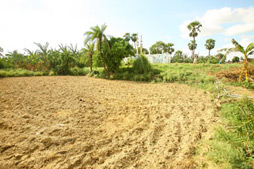 Situated on the northern bank of Ganga about 15 km from Hajipur on Mahnar road. . During the excavation work carried out in year 77-78, 88-89 by the Archeological Survey of India many important historical remains have been found from this place, which include tools of copper and bone, gems ancient coins, terracotta, pieces of utensils, and statues of stone. At present there is Bazaar situated at this place.
Situated on the northern bank of Ganga about 15 km from Hajipur on Mahnar road. . During the excavation work carried out in year 77-78, 88-89 by the Archeological Survey of India many important historical remains have been found from this place, which include tools of copper and bone, gems ancient coins, terracotta, pieces of utensils, and statues of stone. At present there is Bazaar situated at this place.
Second Excavation Site:-
During the excavation work carried out in year 88-89 by the Archeological Survey of India many important historical remains have been found from this place, which include tools 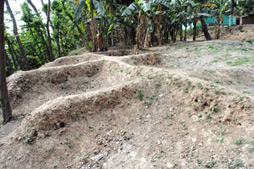 of copper and bone, gems ancient coins, terracotta, pieces of utensils, and statues of stone.Besides these, the other import findings are the Arrow head, terracotta of Helena, Daughter of Seleucus. These are now collected at Chechar Museum.During survey excavations, traces of Buddhist Stupa were also found here.
of copper and bone, gems ancient coins, terracotta, pieces of utensils, and statues of stone.Besides these, the other import findings are the Arrow head, terracotta of Helena, Daughter of Seleucus. These are now collected at Chechar Museum.During survey excavations, traces of Buddhist Stupa were also found here.
Chechar Stupa :-
It covers an area of approximately 500 square metres and is 7 meter high Situated in Chechar village, this Stupa is believed to be of the Ashokan era. This Stupa is situated between 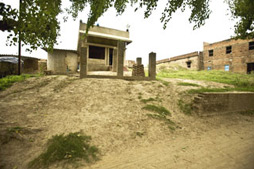 the Chechar Buddhist Temple and the first excavation site. Many important historical remains have been found from this place, which include tools of copper and bone, gems ancient coins, terracotta, pieces of utensils, statues of stone.
the Chechar Buddhist Temple and the first excavation site. Many important historical remains have been found from this place, which include tools of copper and bone, gems ancient coins, terracotta, pieces of utensils, statues of stone.
According to Jayaswal Research Institute Archaeological Explorations this site belongs to Neolithic period.
Chechar Buddhist Temple :-
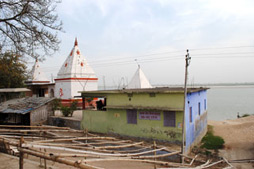 At the bank of river Ganga Chechar Buddhist Temple is an ancient place. In the temple two rare statues of Lord Buddha in Bhumisparsa Mudra are established .
At the bank of river Ganga Chechar Buddhist Temple is an ancient place. In the temple two rare statues of Lord Buddha in Bhumisparsa Mudra are established .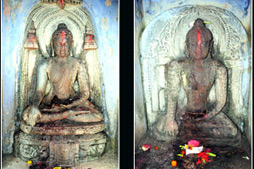 These statues were found from the excavation, in the Chechar village. There are many statues conserved inside and outside of the Buddhist Temple. In this temple complex there are temple of Lord Rama on the northern side of the road and temples of Lord Siva and Goddess Durga on the southern side of the road. The natural beauty of this temple situated on the banks of the river Ganges is exemplary.
These statues were found from the excavation, in the Chechar village. There are many statues conserved inside and outside of the Buddhist Temple. In this temple complex there are temple of Lord Rama on the northern side of the road and temples of Lord Siva and Goddess Durga on the southern side of the road. The natural beauty of this temple situated on the banks of the river Ganges is exemplary.
Jageswar Dham (Chechar ):- It consists an ancient Shiva Linga It is said that is more than thousand years old.
2.Kutubpur (Noonfar Stupa):-
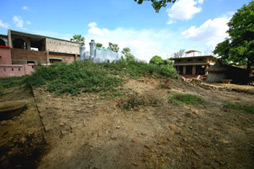 Located at 15 km from Hajipur in kutubpur panchayat of Bidupur Block. It is an eight (8) feet high mound spread over an area of 2 hectare. It is believed that this Stupa was built on the Mortal Remains of one of the four main disciples of Lord Buddha, Mridaglayayan. At present there is a school being run here. In the period of 2500 years, this mound is on the verge of disappearance.
Located at 15 km from Hajipur in kutubpur panchayat of Bidupur Block. It is an eight (8) feet high mound spread over an area of 2 hectare. It is believed that this Stupa was built on the Mortal Remains of one of the four main disciples of Lord Buddha, Mridaglayayan. At present there is a school being run here. In the period of 2500 years, this mound is on the verge of disappearance.
According to Jayaswal Research Institute Archaeological Explorations this site belongs to Neolithic period.
3.Bajidpur Stupa:- It is situated 15 km from hajipur and 3 km south of Mahnar road .It is a 15 – 16 feet high mound spread over 1.5 acre where Government Middle School, Bajidpur is now situated. 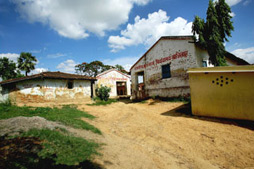 This place is also acclaimed as Anand Stupa. However, it is disputed because there is another legend that claims that according to Buddhist Literature, Anand, after Buddha’s Mahaparinirvana (543 BC) after serving Buddhist Monasteries wanted to aatin Nirvana in Vaishali & thus desired cross The Ganges to attain Nirvana on the other side. On hearing news Magadh King Ajatashatru came to him & requested him to attain Nirvana in Magadh. By then Lichhavi had also crossed the river Ganges, therefore, Anand could attain Nirvana at his desired place. Considering this, Anand in order to avoid a war between the two states, immolated himself in the middle of the river Ganga with the help of his yogic power. Thus half of his mortal remains went to the Republic of Lichhavi and the other half went to the Kingdom of Magadha. With the half of the mortal remains Lichhavi constructed ‘Anand Stupa’ in Vaishali and Ajatshatru constructed another ‘Anand Stupa’ in Rajgir, Nalanda.
This place is also acclaimed as Anand Stupa. However, it is disputed because there is another legend that claims that according to Buddhist Literature, Anand, after Buddha’s Mahaparinirvana (543 BC) after serving Buddhist Monasteries wanted to aatin Nirvana in Vaishali & thus desired cross The Ganges to attain Nirvana on the other side. On hearing news Magadh King Ajatashatru came to him & requested him to attain Nirvana in Magadh. By then Lichhavi had also crossed the river Ganges, therefore, Anand could attain Nirvana at his desired place. Considering this, Anand in order to avoid a war between the two states, immolated himself in the middle of the river Ganga with the help of his yogic power. Thus half of his mortal remains went to the Republic of Lichhavi and the other half went to the Kingdom of Magadha. With the half of the mortal remains Lichhavi constructed ‘Anand Stupa’ in Vaishali and Ajatshatru constructed another ‘Anand Stupa’ in Rajgir, Nalanda.
4.Mathurapur:- It is situated 15 km from hajipur and 3 km south of Mahnar road . It is an 80 feet high mound of earth spread over an area of 1 hectare. At present there is a Hindu Temple situated at this place over lots of bricks dating from the Mauryan Period (2nd century BCE) (. This place is known as a Stupa of the Ashokan era, which was built by King Ashoka on the 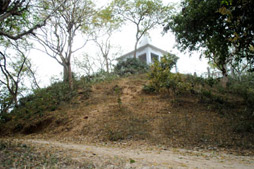 original Mortal Remains of Lord Buddha. On top of the Stupa, ruins of ancient Buddhist Monastery can be seen even today. These ruins were discovered while the top of the mound was being flattened in order to construct the temple. At this place, a rock with the engraved foot print was found during the digging of a well. 270 years after the Mahaparinirvana of Lord Buddha, Ashoka collected three-fourth of the original Mortal remains of Lord Buddha from seven different locations and further divided it into 84000 parts and built Pillars and Stupas at 84000 places along the Nirvana Path of Lord Buddha (most of these Stupas were built of clay). It is believed that this Stupa is one among them. Later a Buddhist Monastery was built at this place between the Buddhist Period – Gupta Period.
original Mortal Remains of Lord Buddha. On top of the Stupa, ruins of ancient Buddhist Monastery can be seen even today. These ruins were discovered while the top of the mound was being flattened in order to construct the temple. At this place, a rock with the engraved foot print was found during the digging of a well. 270 years after the Mahaparinirvana of Lord Buddha, Ashoka collected three-fourth of the original Mortal remains of Lord Buddha from seven different locations and further divided it into 84000 parts and built Pillars and Stupas at 84000 places along the Nirvana Path of Lord Buddha (most of these Stupas were built of clay). It is believed that this Stupa is one among them. Later a Buddhist Monastery was built at this place between the Buddhist Period – Gupta Period.
5.Nawanagar:– According to Jayaswal Research Institute Archaeological Explorations this site belongs to Early medievalperiod.
6.Pakauli:–According to Jayaswal Research Institute Archaeological Explorations this site belongs to NBPW phase period.
7.Kanchanpur :-According to Jayaswal Research Institute Archaeological Explorations this site belongs to Early medieval.
8.Bidupur Dih:– According to Jayaswal Research Institute Archaeological Explorations this site belongs to Chalcolithicperiod.
9.Bhairopur Deorhi:– According to Jayaswal Research Institute Archaeological Explorations this site belongs to Shunga-Kushana period.
10.Khilwat:– According to Jayaswal Research Institute Archaeological Explorations this site belongs to NBPW phase period.
11.Bihbarpur:- According to Jayaswal Research Institute Archaeological Explorations this site belongs to Early medieval period.
12.Kataharia:-
13.Karmopur (Ramdauli Tola):- According to Jayaswal Research Institute Archaeological Explorations this site belongs to NBPW phase period.
14.Amer:–According to Jayaswal Research Institute Archaeological Explorations this site belongs to Early medieval period..
15.Majalispur:-
16.Gopalpur:- According to Jayaswal Research Institute Archaeological Explorations this site belongs to Later Gupta period.
17.Baghsaiatkhan:- According to Jayaswal Research Institute Archaeological Explorations this site belongs to Chalcolithic period.
18.Khalsa:-
19.Gobindpur:-
20.Maniyarpur:- It is situated at Northen bank of River Ganga.
According to Jayaswal Research Institute Archaeological Explorations this site belongs to Medieval period.
In year1975-76 The KP Jayaswal Research Institute, identify this site period Sunga-Kushan.
21.Hasanchak:-
21.Hasanchak:-
22.Mustafapur:-
23.Chandpur:-
24.Saidpur:- According to Jayaswal Research Institute Archaeological Explorations this site belongs to Early medieval period.
Bazitpur Malahi:- The KP Jayaswal Research Institute, during in the course of its Archaeological Explorations brought to light the site period Chalcolithic. Mathura:- The KP Jayaswal Research Institute, during in the course of its Archaeological Explorations brought to light the site period Early medieval. Shampur Dayal:- The KP Jayaswal Research Institute, during in the course of its Archaeological Explorations brought to light the site period Early medieval. Dhanauti:- The KP Jayaswal Research Institute, during in the course of its Archaeological Explorations brought to light the site period NBPW phase. Bazitpur (Tola-Gokhulpur):- The KP Jayaswal Research Institute, during in the course of its Archaeological Explorations brought to light the site period Later Gupta. Khajwatta Dih:- The KP Jayaswal Research Institute, during in the course of its Archaeological Explorations brought to light the site period NBPW phase. Bazidpur Said Bhinda:- The KP Jayaswal Research Institute, during in the course of its Archaeological Explorations brought to light the site period NBPW phase. Khajauti:- The KP Jayaswal Research Institute, during in the course of its Archaeological Explorations brought to light the site period NBPW phase. Phulpura:- The KP Jayaswal Research Institute, during in the course of its Archaeological Explorations brought to light the site period Early medieval. Chak Sikander Garh:- The KP Jayaswal Research Institute, during in the course of its Archaeological Explorations brought to light the site period Early medieval. Kakrahta (Milky):- The KP Jayaswal Research Institute, during in the course of its Archaeological Explorations brought to light the site period Early medieval. Sadullahpur Dhobauli:- The KP Jayaswal Research Institute, during in the course of its Archaeological Explorations brought to light the site period Kushana
